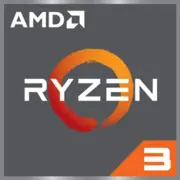AMD Ryzen 3 PRO 2200G with Radeon Vega 8 Graphics

AMD Ryzen 3 PRO 2200G with Radeon Vega 8 Graphics: Budget Processor in 2025
April 2025
Key Features: Architecture and Performance
Zen Architecture and 14nm Process Technology
The AMD Ryzen 3 PRO 2200G, released in 2018, is based on the first-generation Zen microarchitecture and a 14nm FinFET process. This is a 4-core/4-thread chip with a base clock speed of 3.5 GHz (up to 3.7 GHz in Turbo mode). The integrated Radeon Vega 8 graphics (8 compute units, 1100 MHz) provides baseline performance for undemanding tasks.
Key Features:
- Integrated Graphics: Vega 8 handles Full HD video, office applications, and light gaming.
- Energy Efficiency: With a TDP of 65W, it is suitable for compact PCs.
- AMD Technologies: Support for Precision Boost, Virtualization, StoreMI.
Performance in 2025:
- Office Tasks (browser, Word, Excel) — smooth operation without delays.
- Multimedia: Streaming 4K video (with hardware decoding).
- Gaming: CS:GO, Dota 2, Minecraft at low/medium settings (30-45 FPS in Full HD).
Compatible Motherboards: AM4 Socket and Chipsets
Choosing a Motherboard in 2025
The processor uses an AM4 socket, which is still available on the secondary market. Suitable chipsets include:
- A320/B350/X370 — basic models without overclocking support (A320) or with limited overclocking capabilities (B350/X370).
- B450/X470 — require a BIOS update for compatibility.
Selection Recommendations:
- Look for motherboards with HDMI/DVI-D ports for connecting monitors via integrated graphics.
- Check for USB 3.1 Gen1 and M.2 NVMe support (e.g., ASUS Prime B450M-A, ~$60-80).
- Ensure that the BIOS is updated to a version that supports the Ryzen 2000 series.
Supported Memory: DDR4 and Dual Channel Mode
The processor is compatible with DDR4-2933 MHz (official support). For optimal Vega 8 performance:
- Use a dual-channel configuration (2×4 GB or 2×8 GB).
- Optimal modules: DDR4-2666/2933 MHz with low timings (CL16).
Example: A combination of 2×8 GB DDR4-3200 (costing ~$40-60) will improve FPS in games by 15-20% compared to single-channel mode.
Power Supply: Power Calculation
With a TDP of 65W and no discrete graphics card, a 400-450W power supply is sufficient. For instance:
- Corsair CX450 (450W, 80+ Bronze, ~$55) — a reliable option.
- Be Quiet! System Power 10 (400W, ~$45) — for budget builds.
Tip: If planning to install a graphics card (e.g., Radeon RX 6600), choose a power supply rated at 550-650W.
Pros and Cons of Ryzen 3 PRO 2200G in 2025
Advantages:
- Price: New processors can be found for $80-100 (remaining stock).
- Energy Efficiency: Suitable for HTPCs or office PCs.
- Vega 8 Graphics: Better than Intel UHD 630 in similar models.
Disadvantages:
- Weak Cores: 4 threads are insufficient for multitasking (streaming + gaming).
- Outdated Process Technology: 14nm compared to 7nm in Ryzen 5000/7000.
- No PCIe 4.0 Support — limits the speed of NVMe drives.
Use Cases
1. Office and Study
Ideal for document work, Zoom conferences, and web surfing. Example: A build with a 256 GB SSD and 8 GB DDR4 will cost around ~$200-250.
2. Media Center
Connect to TV via HDMI, capable of playing 4K HDR (Netflix, YouTube).
3. Light Gaming
Games from the 2010s (Skyrim, GTA V) or indie titles (Hollow Knight, Stardew Valley).
Comparison with Competitors
Intel Core i3-8100 (2017)
- Similar price (~$90), 4 cores/4 threads, UHD 630 graphics.
- Vega 8 is 30-40% faster in games.
AMD Ryzen 5 3400G (2019)
- 4 cores/8 threads, Vega 11. On the secondary market, it costs around ~$120-150. A better choice for gaming.
Intel Core i3-12100 (2023)
- 4 cores/8 threads, UHD 730 graphics. New models start at $130. Significantly more powerful but requires a separate graphics card.
Practical Build Tips
1. Motherboard: ASRock A320M-HDV (minimum price, ~$50).
2. Memory: 2×8 GB DDR4-3200 (TeamGroup Vulcan Z, ~$55).
3. Storage: Kingston NV2 500 GB (PCIe 4.0 not supported, but SSD will speed up the system, ~$35).
4. Case: Thermaltake Versa H15 (compact, good ventilation, ~$45).
Important: Install Radeon Adrenalin drivers for graphics optimization.
Final Conclusion: Who is the Ryzen 3 PRO 2200G Suitable For?
This processor is relevant for:
- Budget PCs: If you need a computer for $200-300 for basic tasks.
- Upgrading Old Systems: Replacing an Athlon X4 or Intel Pentium on the AM4 platform.
- Fallback Solutions: For offices where high performance is not required.
Why Not to Consider in 2025:
- For the same $150-200, you can build a system based on Ryzen 5 5600G (6 cores/12 threads, Vega 7) with support for PCIe 4.0 and DDR4-3200.
Conclusion
The Ryzen 3 PRO 2200G is an outdated, yet still viable option for ultra-budget builds. It should only be considered under strict financial constraints or for specific tasks where integrated graphics and 4 cores are sufficient. In 2025, the market offers more advantageous alternatives, but for certain scenarios, this chip remains a workhorse.
Basic
CPU Specifications
Memory Specifications
GPU Specifications
Miscellaneous
Benchmarks
Compared to Other CPU
Share in social media
Or Link To Us
<a href="https://cputronic.com/cpu/amd-ryzen-3-pro-2200g-with-radeon-vega-8-graphics" target="_blank">AMD Ryzen 3 PRO 2200G with Radeon Vega 8 Graphics</a>